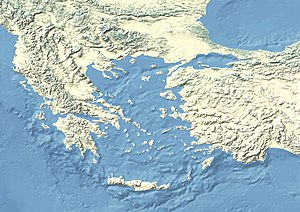Parium
Parium (or Parion;
History
Founded in 709 B.C., the ancient city of Parion is located in the village of Kemer in the township of Biga in Çanakkale province of Turkey, currently. A major coastal city with two harbors in the Roman period, Parium had intensive relations with Thrace and Anatolia throughout history. This was the main customs station through which all Istanbul-bound goods from Greece and the Aegean had to pass.
According to
It belonged at one point to the
It then belonged to the
Christian history
The Acts of the
At first a suffragan of the
In 1354 the residential see of
The see is included in the Catholic Church's list of titular sees.[4]
The ruins of Parium were under Ottoman rule at the Greek village of
Archaeology
Archaeologists have been carrying out excavations at the ancient site since 2005. Sarcophagi and graves, as well as ancient artifacts were found in the area. In 2017, ancient toys from the
Notable people
- Herophantos (Ancient Greek: Ἡρόφαντος) of Parion, tyrant of Parion.[6]
- Peregrinus Proteus, a cynic philosopher during the second century AD.[7][8]
See also
Notes
- ^ Strabo. Geographica. Vol. xiii p. 588. Page numbers refer to those of Isaac Casaubon's edition.
- ISBN 9781910589465.
- ^ Asia Minor Coins - ancient coins of Parium
- ISBN 978-88-209-9070-1), p. 950
- ^ 2,000-year-old toys discovered inside children's tombs in Turkey's Çanakkale
- ^ Herodotus, Histories, 4.138
- ^ Harry Thurston Peck, Harpers Dictionary of Classical Antiquities (1898), Peregrinus Proteus
- ^ A Dictionary of Greek and Roman biography and mythology, Peregrinus Proteus
Bibliography
- P. Frisch (ed.), Die Inschriften von Parion (Bonn, 1983) (Inschriften griechischer Städte aus Kleinasien 25).
External links
 Herbermann, Charles, ed. (1913). "Parium". Catholic Encyclopedia. New York: Robert Appleton Company.
Herbermann, Charles, ed. (1913). "Parium". Catholic Encyclopedia. New York: Robert Appleton Company.
![]() This article incorporates text from a publication now in the public domain: Herbermann, Charles, ed. (1913). "Parium". Catholic Encyclopedia. New York: Robert Appleton Company.
This article incorporates text from a publication now in the public domain: Herbermann, Charles, ed. (1913). "Parium". Catholic Encyclopedia. New York: Robert Appleton Company.

